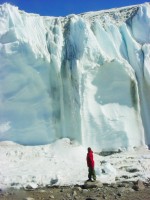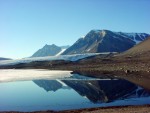McMurdo study focuses on ecosystem disturbances.
Lakes in the McMurdo Dry Valleys (MCM) of Antarctica are among the most pristine ecosystems on our planet in which to study biogeochemical transformations. The first scientific observations on these lakes came from Captain Robert Falcon Scott’s Discovery Expedition in 1903. These early records made it possible to recreate historic lake levels and examine how much water levels have risen in the lakes over the past century (Chinn, 1993). The lakes in the MCM are extremely dynamic systems that respond rapidly to what would be considered subtle climate variations in more temperate environments (Lyons et al., 2001). Owing to the large amount of ice poised near the melting point during the austral summer, small climatic changes can lead to major changes in liquid water production, producing a cascade of ecosystem responses (Doran et al., 2002).
During the austral summer of 2001-2002, the Taylor Valley experienced a significant warming event which triggered what we refer to further as “the flood.” During the 2002-2003 season, we investigated lakes in the MCM to determine the impact of the warming event and subsequent high melt input into the lakes. Regional warming during the flood caused increased glacial run-off, record stream discharge, an increase in lake levels, and thinning of the permanent ice covers. Lake volumes in all dry valley lakes increased following the flood, reversing a declining trend reported from 1993 to 2000 (Doran et al., 2002). This decline in lake volumes was rapidly corrected with a single flood. According to historical measurements these periods of oscillating lake levels are not uncommon in the ecosystem. These changes in the physical environment drove subsequent changes in the biogeochemistry of MCM lakes. Our data show that primary production in West Lake Bonney during the flood was reduced by 23 percent due to of stream induced water column turbidity. Increased nutrient levels within the lakes occurred in the year following the temperature-induced high flow year. For example, soluble reactive phosphorus on Lake Fryxell was four times the long-term average loading rates. These high nutrient levels corresponded with increased primary production in the upper water columns of Lakes Bonney and Fryxell. Depth integrated chlorophyll-a values increased 149 percent in East Lake Bonney, 48 percent in West Lake Bonney, and showed little change in Lake Fryxell. Chlorophyll-a in Lake Hoare decreased 18 percent compared to long-term averages in our 10-year monitoring program, presumably due to decreased under-ice photosynthetically active radiation (or, commonly, PAR) caused by increased sediment loads on the ice cover.
Disturbances are discrete events in time that disrupt ecosystems, change resource or substrate availability, and alter the physical environment. Organisms in the dry valleys are poised at the edge of their survival ranges and are highly susceptible to disturbances, particularly when water changes from solid to liquid. Liquid water affords a key habitat in the frozen deserts of the MCM, and acts as a medium to transport nutrients from glaciers, soils, and streambeds to the lakes. Clearly, the common currency linking individual components within the dry valley ecosystem is the availability of liquid water.
Overall, our data suggests that the warming event served to “recharge” the ecosystem with liquid water and associated nutrients and had a clear effect on lake biota. If periodic warming events have occurred in the MCM dry valleys in the past, then such “floods” may play an important role in the long-term maintenance of liquid water in these dry valley lakes. The high variability in lake responses shown in this study reaffirms the unique character of each lake in the McMurdo Dry Valleys, and drives home the need for continued long-term monitoring of these systems. Episodic climate events, such as infrequent floods, may have a long-term influence on the structure and functioning of these ecosystems. In an environment where life is limited by the availability of liquid water, floods such as that of 2001-2002 appear to be significant and reoccurring events that govern life processes in this extreme polar desert ecosystem.
This report is based on the paper, Christine M. Foreman, Craig F. Wolf, and John C. Priscu. 2004. Impact of episodic warming events on the physical, chemical and biological relationships of lakes in the McMurdo Dry Valleys, Antarctica. Aquatic Geochemistry, 10: 239-268.
References
Chinn T.J. (1993) Physical hydrology of the Dry Valley lakes. In Physical and Biogeochemical Processes in Antarctic Lakes, W. J. Green and E. I. Friedman Eds. Antarctic Research Series. Volume 59, 1-51.
Doran P. T, J. C. Priscu, W. B. Lyons, J. E. Welsh, A. G. Fountain, D. M. McKnight, D. L. Moorhead, R. A. Virginia, D. H. Wall, G. D. Clow, C. H. Fritsen, C. P. McKay and A. N. Parsons (2002) Antarctic climate cooling and terrestrial ecosystem response. Nature. 415, 517-520.
Lyons W.B., K. A. Welch, J.C. Priscu, J. Laybourn-Parry, D. Moorhead, D. M. McKnight, P.T. Doran, M. Tranter (2001) The McMurdo Dry Valleys Long-Term Ecological Research Program: New Understanding of the Biogeochemistry of the Dry Valley Lakes: A Review. Polar Geography. 25(3), 202-217.
Christine M. Foreman, Craig F. Wolf, W. B. Lyons, and John C. Priscu, MCM/Montana State University, Center for Biofilm Engineering & Dept. of Land Resources and Environmental Sciences

 Enlarge this image
Enlarge this image
